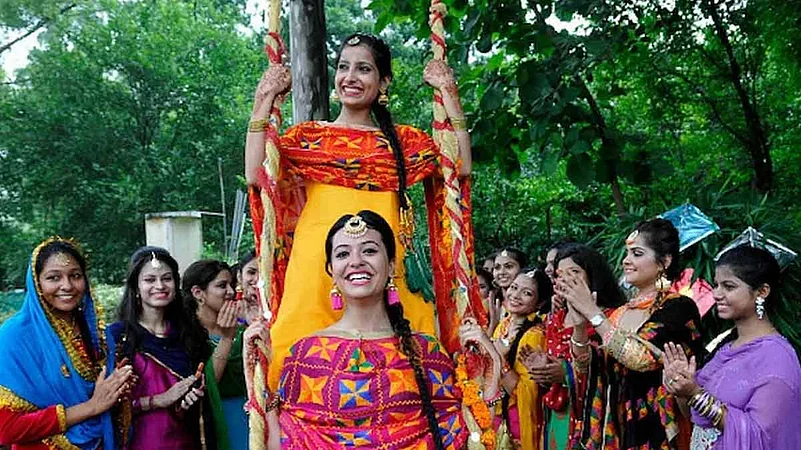Hariyali Teej is a joyful and colorful festival celebrated mainly in North India, especially in states like Rajasthan, Uttar Pradesh, Madhya Pradesh, and Bihar. It takes place during the monsoon season, in the month of Shravan (Sawan), usually two days before Raksha Bandhan. The word “Hariyali” means greenery, and “Teej” refers to the third day after the new moon. As the name suggests, the festival celebrates the arrival of rains and the beauty of nature in full bloom.
But Hariyali Teej is more than just a seasonal festival. It is also a time of devotion, tradition, and community bonding, especially for women. It beautifully combines eco-awareness, cultural values, and religious devotion.
A Celebration of Nature and Season
During the summer months, much of northern India becomes dry and hot. But when the rains come in Shravan, everything turns green and fresh. Trees grow new leaves, crops start sprouting, and the environment feels alive again. Hariyali Teej celebrates this change in nature. It is a way of thanking the earth for its renewal and showing joy for the greenery all around.
People decorate their homes and surroundings with leaves, flowers, and colorful fabrics. Women wear bright green clothes, which symbolize life, fertility, and happiness. Green bangles, mehndi (henna), and traditional jewelry are also part of the celebration. Everything about this festival reflects the color and freshness of the monsoon season.
Devotion and Mythology
Hariyali Teej also has deep spiritual meaning. It marks the reunion of Lord Shiva and Goddess Parvati. According to Hindu mythology, Parvati performed great penance for many years to win Shiva’s love and become his wife. Her devotion was finally rewarded, and they were united. Teej celebrates this divine union and is seen as a symbol of love, loyalty, and marriage.
On this day, married women pray for the well-being of their husbands and a happy married life, while unmarried girls seek blessings for a good future partner. Fasting is common, and many women do not eat or drink all day as part of their religious vow. They offer prayers, sing devotional songs, and listen to stories of Shiva and Parvati’s marriage.
Swings and Songs
One of the most joyful parts of Hariyali Teej is the tradition of swinging. Swings are hung from trees, decorated with flowers and cloth, and women take turns enjoying them. Groups of women gather to sing traditional folk songs, often about love, nature, and marriage. These gatherings bring laughter, bonding, and a strong sense of community.
In villages and even in cities, parks and courtyards become lively with the sounds of singing and the sight of women in bright clothing enjoying the swings. The activity not only offers fun but also brings people closer together, keeping old customs alive in a modern world.
Local Customs and Celebrations
Different regions have their own ways of celebrating Hariyali Teej. In Rajasthan, royal families once celebrated it with grand processions, and even today, special events are held in cities like Jaipur. Women receive gifts from their parents, especially newly married daughters, including sweets, clothes, and bangles. Traditional dishes like ghewar, kheer, and poori are prepared and shared.
In many areas, fairs and cultural programs are organized, featuring dance, music, and local crafts. The whole atmosphere is festive and filled with a sense of celebration for both tradition and nature.
A Festival of Joy and Awareness
Hariyali Teej reminds us to appreciate the simple joys of life—the beauty of rain, the freshness of greenery, and the strength of human relationships. In a world that’s becoming more fast-paced and digital, such festivals offer a moment to pause and reconnect—with nature, with culture, and with each other.
It also gently encourages environmental awareness. By celebrating greenery and seasonal change, it reminds us of the importance of trees, rain, and natural balance.
Hariyali Teej is a beautiful blend of nature, tradition, and devotion. It brings color and joy to the rainy season, especially for women who play a central role in the celebrations. From fasting and prayers to swings and songs, every part of the festival reflects happiness, hope, and harmony with the earth.
As we celebrate Hariyali Teej, we are not only honoring old customs but also embracing the green joy that nature brings into our lives each year.



























